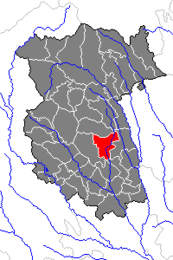Hartberg
| Hartberg | |
|---|---|
 Hartberg | |
Location within Hartberg-Fürstenfeld district
| |
| Coordinates: 47°16′50″N 15°58′12″E / 47.28056°N 15.97000°ECoordinates: 47°16′50″N 15°58′12″E / 47.28056°N 15.97000°E | |
| Country | Austria |
| State | Styria |
| District | Hartberg-Fürstenfeld |
| Government | |
| • Mayor | Karl Pack (ÖVP) |
| Area | |
| • Total | 21.54 km2 (8.32 sq mi) |
| Elevation | 359 m (1,178 ft) |
| Population (1 January 2013)[1] | |
| • Total | 6,445 |
| • Density | 300/km2 (770/sq mi) |
| Time zone | CET (UTC+1) |
| • Summer (DST) | CEST (UTC+2) |
| Postal codes | 8230, 8274, 8295 |
| Area code | 03332 |
| Vehicle registration | HF |
| Website | www.hartberg.at |
Hartberg is a city in Styria, Austria, the capital of the Hartberg-Fürstenfeld (district). As of the census of 2001, it has a population of 6,547 in an area of 21.54 km². About 68 km up the A2 is the large city of Graz.
This town has a long and rich history. A settlement was located here in the Neolithic ages. One of the most important, prehistoric settlements of Styria developed on "Ringkogel" in the 3rd century BC. A massive protective wall surrounded it. Only two towers remain of the 7-8 metre high and 1500 metre long wall. (Schölbinger Tower and Reck Tower). The first mention of Hartberg as a city was in a 1286 document. During the 15th century it was conquered by King Matthias Corvinus of Hungary. A huge fire destroyed the town up to a few houses, but the population has been continually on the rise since then.
A massive protective wall surrounded it. In 1122 margrave Leopold I of Styria founded "Hartberg". Hartberg was even a central village in Styria for a certain time. The first written reference to Hartberg as "civitas" was in 1286.
References
External links
| Wikimedia Commons has media related to Hartberg. |
